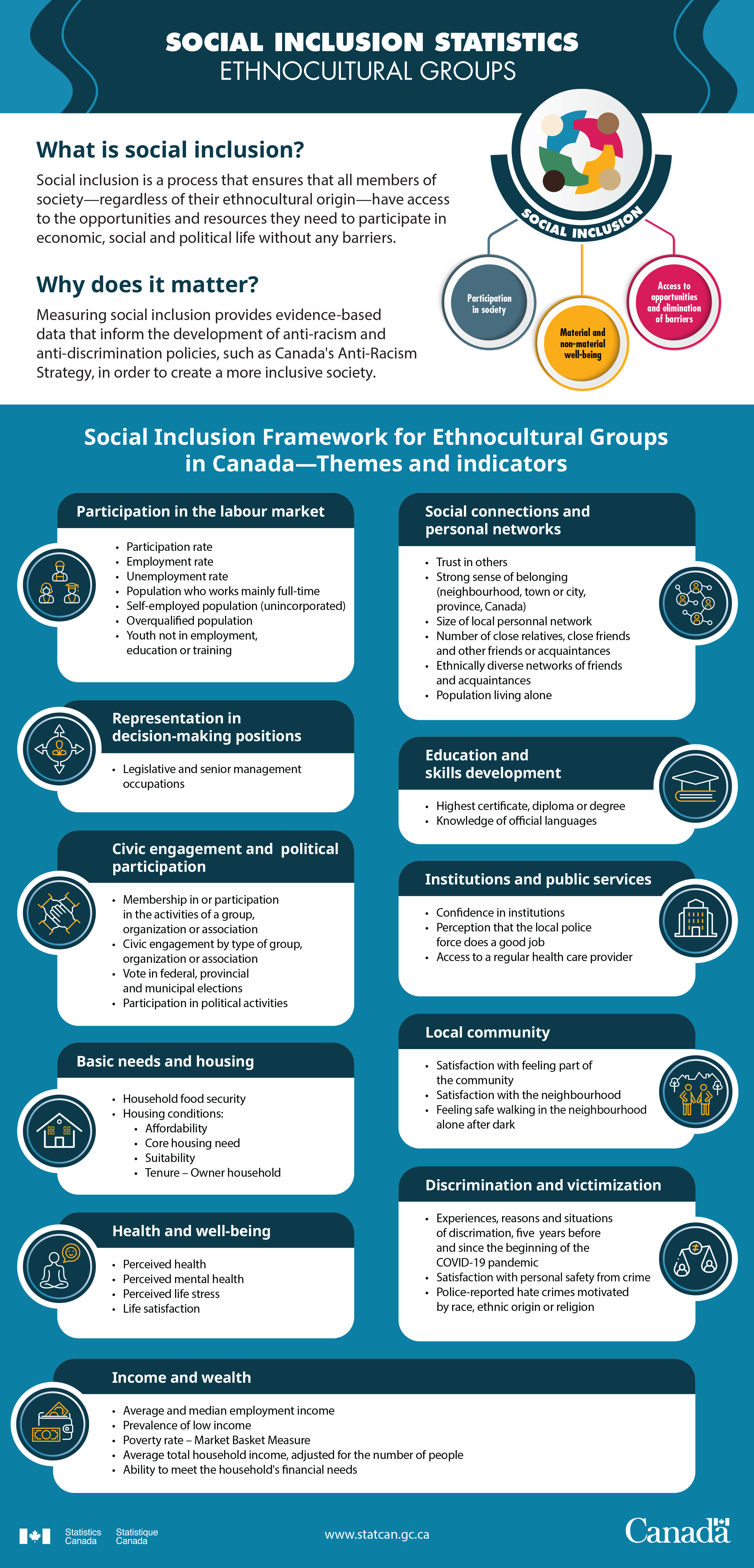
Description: Social Inclusion Framework for Ethnocultural Groups in Canada
The title of this infosheet is "Social inclusion Framework for Ethnocultural Groups in Canada."
The content of this infosheet is presented under the "Social Inclusion Statistics—Ethnocultural Groups" banner and is divided into two sections.
The first section presents the following three pieces of information:
- What is social inclusion?
Social inclusion is a process that ensures that all members of society—regardless of their ethnocultural origin—have access to the opportunities and resources they need to participate in economic, social and political life without any barriers. - A logo with three arrows labelled "Participation in society," "Material and non‑material well‑being" and "Access to opportunities and elimination of barriers" that point to and support the circled symbol titled "Social inclusion."
- Why does it matter?
Measuring social inclusion provides evidence-based data that inform the development of anti-racism and anti-discrimination policies, such as Canada's Anti-Racism Strategy, in order to create a more inclusive society.
The second section of the infosheet, titled "Social Inclusion Framework for Ethnocultural Groups in Canada—Themes and indicators," displays 11 textboxes, each of which includes the title of the theme, an icon and a list of the social inclusion indicators. The number of indicators listed in each textbox varies depending on the theme.
Participation in the labour market
The textbox titled "Participation in the labour market" includes an icon illustrating three tradespeople and lists the following indicators:
- participation rate
- employment rate
- unemployment rate
- population who works mainly full time
- self-employed population (unincorporated)
- overqualified population
- youth not in employment, education or training.
Representation in decision-making positions
The textbox titled "Representation in decision-making positions" includes an icon illustrating a person at the centre of four outgoing arrows and includes the following indicator:
- legislative and senior management occupations.
Civic engagement and political participation
The text box titled "Civic engagement and political participation" includes an icon illustrating four hands on top of one another and lists the following indicators:
- membership in or participation in the activities of a group, organization or association
- civic engagement by type of group, organization or association
- vote in federal, provincial and municipal elections
- participation in political activities.
The text box titled "Basic needs and housing" includes an icon illustrating a house and lists the following indicators:
- household food security
- housing conditions:
- affordability
- core housing need
- suitability
- tenure – owner household.
The textbox titled "Health and well-being" includes an icon illustrating a person in a meditation position and lists the following indicators:
- perceived health
- perceived mental health
- perceived life stress
- life satisfaction.
The textbox titled "Income and wealth" includes an icon illustrating a wallet with money and lists the following indicators:
- average and median employment income
- prevalence of low income
- poverty rate – Market Basket Measure
- average total household income, adjusted for the number of people
- Ability to meet household’s financial needs.
Social connections and personal networks
The textbox titled "Social connections and personal networks" includes an icon illustrating a network of people connected to each other by lines and lists the following indicators:
- trust in others
- strong sense of belonging (neighbourhood, town or city, province, Canada)
- size of local personal network
- number of close relatives, close friends, other friends or acquaintances
- ethnically diverse networks of friends and acquaintances
- population living alone.
Education and skills development
The textbox titled "Education and skills development" includes an icon illustrating a graduation cap on a book and lists the following indicators:
- highest certificate, diploma or degree
- knowledge of official languages.
Institutions and public services
The textbox titled "Institutions and public services" includes an icon illustrating a heritage building and lists the following indicators:
- confidence in institutions
- perception that the local police force does a good job
- access to a regular health care provider.
The textbox titled "Local community" includes an icon illustrating a neighbourhood and lists the following indicators:
- satisfaction with feeling part of the community
- satisfaction with the neighbourhood
- feeling safe walking in the neighbourhood alone after dark.
Discrimination and victimization
The textbox titled "Discrimination and victimization" includes an icon illustrating an unequal balance and lists the following indicators:
- experiences, reasons and situations of discrimination, five years before and since the beginning of COVID-19 pandemic
- satisfaction with personal safety from crime
- police-reported hate crimes motivated by race, ethnicity or religion.